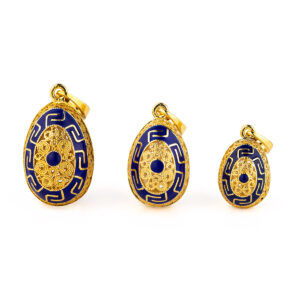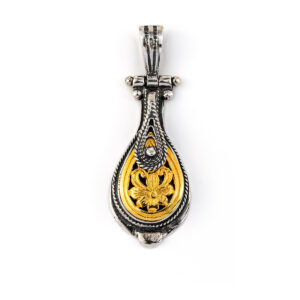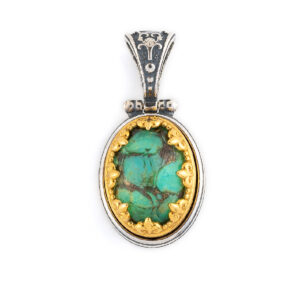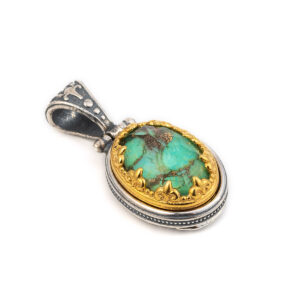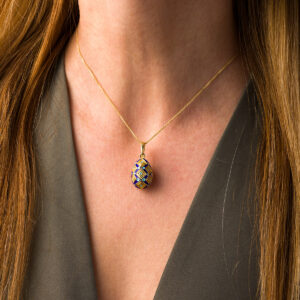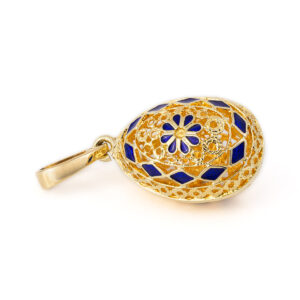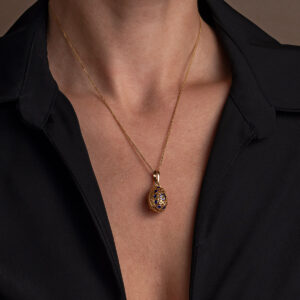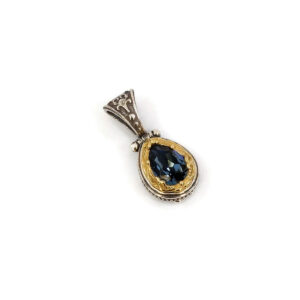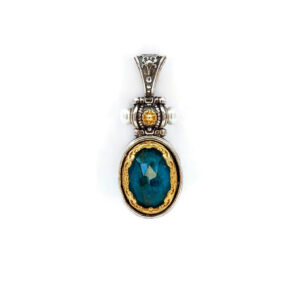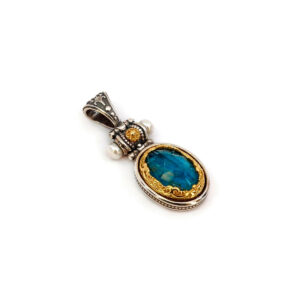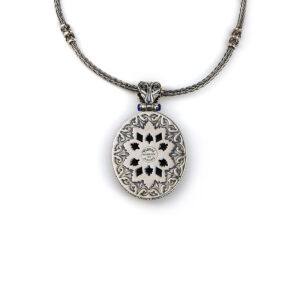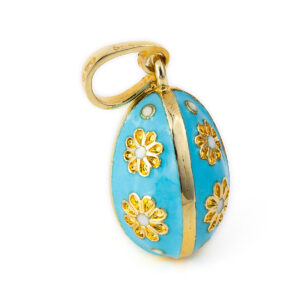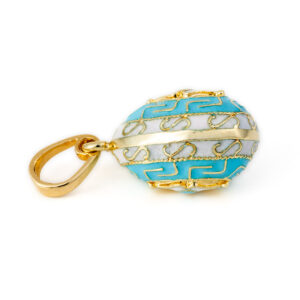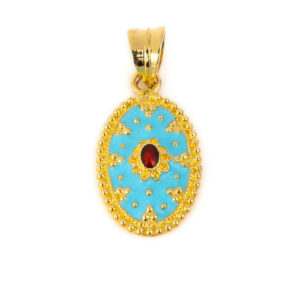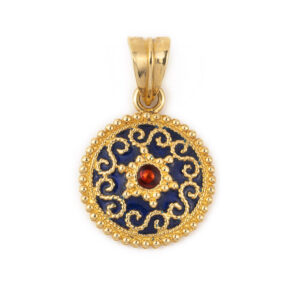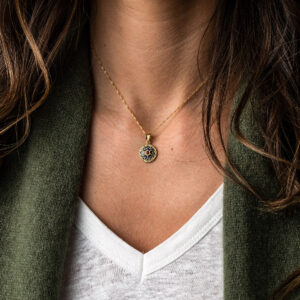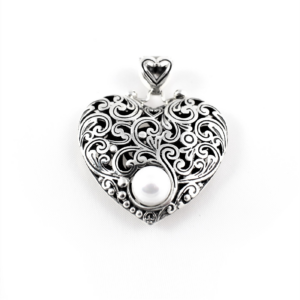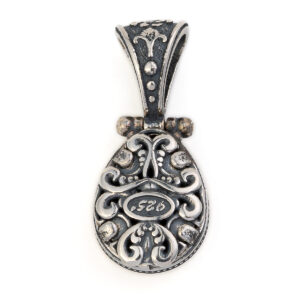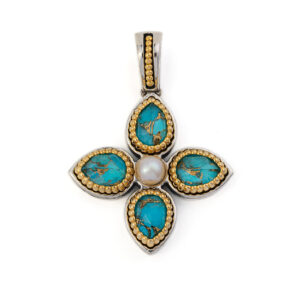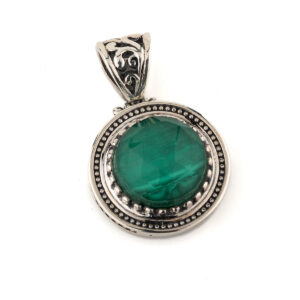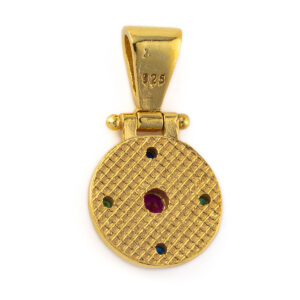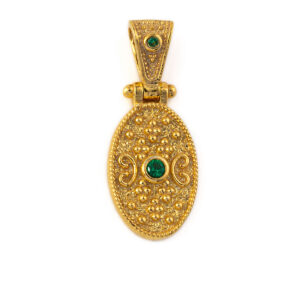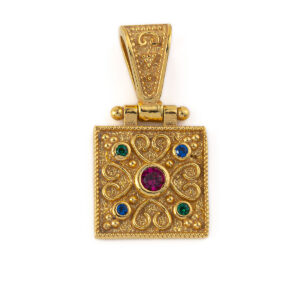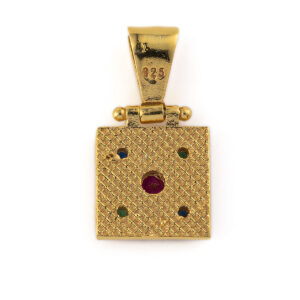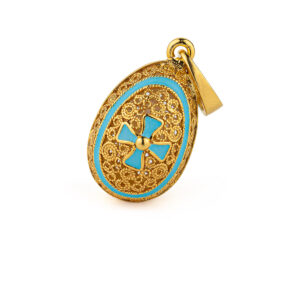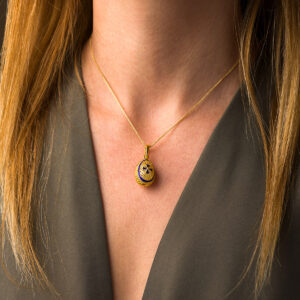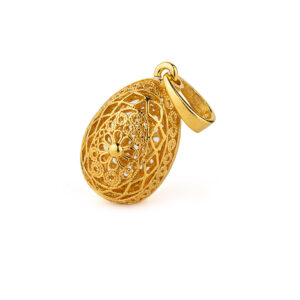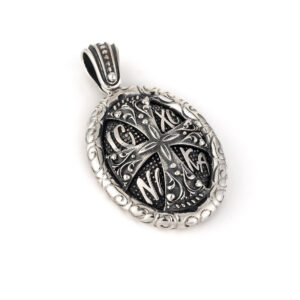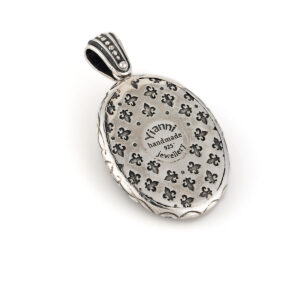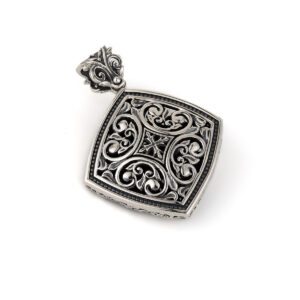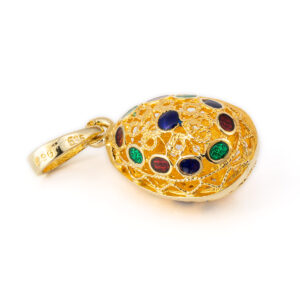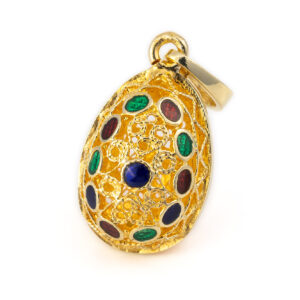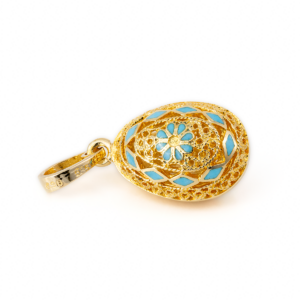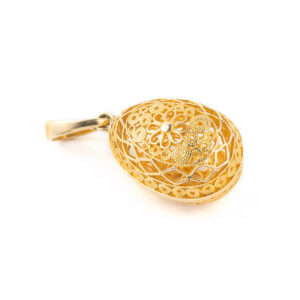Pendants
Meander Filigree Egg Pendant Necklace with Blue Enamel – Sterling Silver Gold Plated
The pendant is embellished with fine filigree and blue enamel in Faberge style. Also, the pendant is decorated with a Meander design.
Made of 925 sterling silver and gold plated.
The chain shown is included.
Filigree is a delicate kind of jewelry metalwork, made with tiny beads or twisted threads, or both in combination, soldered together or to the surface of an object of the same metal and arranged in artistic motifs. The art of filigree dates back to ancient history. The first of the found jewelry in this technique has been found in Mesopotamia and dates to thousands of years BC. In the ancient world and particularly in Asia Minor, this art grew at the highest level.
Fabergé egg is a jeweled egg created by the House of Fabergé, in St. Petersburg, Imperial Russia. Virtually all were manufactured under the supervision of Peter Carl Fabergé between 1885 and 1917,[citation needed] the most famous being the 50 “Imperial” eggs, 43 of which survive, made for the Russian Tsars Alexander III and Nicholas II as Easter gifts for their wives and mothers. The first Fabergé egg was crafted for Tsar Alexander III, who had decided to give his wife, Empress Maria Feodorovna, an Easter egg in 1885. Peter Carl Fabergé was a Russian jeweler best known for the famous Fabergé eggs made in the style of genuine Easter eggs, using precious metals and gemstones. He’s the founder of the famous jewelry legacy House of Fabergé. (Wikipedia)
Meander or Meandros design, one of the most historic symbols of the Greek World, also called Greek Key and symbolizes long life and eternity. The pattern with Meandro was used in antiquity to decorate the frieze of temples.
Byzantine pendant with engravings – 925 sterling silver and gold plated
Pendant with engravings.
Made in 925 sterling silver and gold plated.
The shape and decoration of these earrings shows the influence of the Byzantine art.
Byzantine Doublet Green Copper Pendant – Sterling Silver and Gold Plated
This pendant is inspired by Byzantine Historical period respecting Greek traditional art. A beautiful pendant with doublet green copper gemstone
Handmade item. As in all handmade items there may be small differences in weight and dimensions and this is what makes them unique and precious.
Made in 925⁰ sterling silver and gold plated.
Doublet jewelry is very special piece of jewel due to the way it is compounded. Doublet is a modern and very fashionable design that was invented in order to make stones such as lapis lazuli, turquoise and other non-transparent stones glow and create unique colors from them. There is the unification of two gemstones, which usually consists of quartz and another non transparent stone. Quartz in this case gives radiance to the other stone and also volume. Due to its composition doublet jewelry needs to be looked after. To keep them in good shape you need to avoid contact with chemicals, such as soap or perfumes. Quartz has the tendency to lose its shininess when touched with sweaty hands, we advise you from time to time to you use a soft cloth to polish and give brightness to it.
Egg pendant necklace with Square Motifs – Sterling Silver Gold Plated with Enamel
A beautifully crafted egg-shaped pendant, made of 925 sterling silver and gold plated decorated with enamel and square motifs.
Made of 925 sterling silver and gold plated.
The chain shown is included.
14k Gold and Blue Enamel Filigree Egg Pendant
645,00€The pendant is embellished with fine filigree and blue enamel in Faberge style.
Used as a charm or as a pendant.
Pick up a beautiful gift inspired by the majestic art of Fabergé!
Made in 14k yellow gold.
Handmade in Greece.
History
Filigree is a delicate kind of jewelry metalwork, made with tiny beads or twisted threads, or both in combination, soldered together or to the surface of an object of the same metal and arranged in artistic motifs. The art of filigree dates back to ancient history. The first of the found jewelry in this technique has been found in Mesopotamia and dates to thousands of years BC. In the ancient world and particularly in Asia Minor, this art grew at the highest level.
Rosette The rosette (rose) is a timeless jewel, symbol, and amulet. The origin of the term is the Greek word for rose – rodon (ρόδον). Its use began in the Mycenaean era and continues as far as the 2nd millennia BC. The Mycenaean Rosette is a motif that was widespread throughout Mesopotamia, Egypt, Greece, and other ancient civilizations. Rosette or Rodax was probably the most popular and favorite decorative element in the Mycenaean era, classical antiquity, and Byzantine times.
Fabergé egg is a jeweled egg created by the House of Fabergé, in St. Petersburg, Imperial Russia. Virtually all were manufactured under the supervision of Peter Carl Fabergé between 1885 and 1917,[citation needed] the most famous being the 50 “Imperial” eggs, 43 of which survive, made for the Russian Tsars Alexander III and Nicholas II as Easter gifts for their wives and mothers. The first Fabergé egg was crafted for Tsar Alexander III, who had decided to give his wife, the Empress Maria Feodorovna, an Easter egg in 1885. Peter Carl Fabergé was a Russian jeweller best known for the famous Fabergé eggs made in the style of genuine Easter eggs, using precious metals and gemstones. He’s the founder of the famous jewelry legacy House of Fabergé.
Byzantine Pendant with London Blue Topaz Swarovski Stone – Sterling Silver 925 Gold Plated
Byzantine pendant with natural pearl and doublet apatite 10mmX14mm oval gemstone.
Sterling Silver 925 With gold plated part.
Handmade item.
Byzantine Pendant with Natural Pearl and Apatite Doublet Stone – Sterling Silver 925 Gold Plated
Byzantine pendant with natural pearl and doublet apatite 10mmX14mm oval gemstone.
Sterling Silver 925 With gold plated part.
Handmade item.
Byzantine Drop Pendant with Lapis Sterling Silver – Yianni Jewelry
A pendant inspired by a Byzantine design, decorated with Lapis Lazuli gemstone.
Made of 925° sterling silver.
Handmade Item.
The chain shown is not included but is available in our store.
Silver creations of Yianni Jewelry, created by Garbis Khacherian, a silversmith trader since 1987.
Filigree Egg Pendant with Flowers – 14k Gold and Turquoise Enamel
612,00€ – 952,00€The pendant is embellished with flowers in Faberge style.
Used as a charm or as a pendant.
Pick up a beautiful gift inspired by the majestic art of Fabergé!
Made in 14k gold and turquoise enamel.
The chain shown is our 14K Gold Chain (not included).
The rosette (rose) is a timeless jewel, symbol, and amulet. The origin of the term is the Greek word for rose – rodon (ρόδον). Its use began in the Mycenaean era and continues as far as the 2nd millennia BC. The Mycenaean Rosette is a motif that was widespread throughout Mesopotamia, Egypt, Greece, and other ancient civilizations. Rosette or Rodax was probably the most popular and favorite decorative element in the Mycenaean era, classical antiquity, and Byzantine times.
Fabergé egg is a jeweled egg created by the House of Fabergé, in St. Petersburg, Imperial Russia. Virtually all were manufactured under the supervision of Peter Carl Fabergé between 1885 and 1917,[citation needed] the most famous being the 50 “Imperial” eggs, 43 of which survive, made for the Russian Tsars Alexander III and Nicholas II as Easter gifts for their wives and mothers. The first Fabergé egg was crafted for Tsar Alexander III, who had decided to give his wife, Empress Maria Feodorovna, an Easter egg in 1885. Peter Carl Fabergé was a Russian jeweler best known for the famous Fabergé eggs made in the style of genuine Easter eggs, using precious metals and gemstones. He’s the founder of the famous jewelry legacy House of Fabergé.
As in all handmade items, there may be small differences in weight and dimensions, making them unique and precious.
Egg Pendant with Rosette Flowers – 14k Gold
680,00€The pendant is embellished with rosette flowers in Faberge style.
Used as a charm or as a pendant.
Pick up a beautiful gift inspired by the majestic art of Fabergé!
Made in 14k gold and turquoise enamel.
Fabergé egg is a jeweled egg created by the House of Fabergé, in St. Petersburg, Imperial Russia. Virtually all were manufactured under the supervision of Peter Carl Fabergé between 1885 and 1917,[citation needed] the most famous being the 50 “Imperial” eggs, 43 of which survive, made for the Russian Tsars Alexander III and Nicholas II as Easter gifts for their wives and mothers. The first Fabergé egg was crafted for Tsar Alexander III, who had decided to give his wife, Empress Maria Feodorovna, an Easter egg in 1885. Peter Carl Fabergé was a Russian jeweler best known for the famous Fabergé eggs made in the style of genuine Easter eggs, using precious metals and gemstones. He’s the founder of the famous jewelry legacy House of Fabergé.
The rosette (rose) is a timeless jewel, symbol, and amulet. The origin of the term is the Greek word for rose – rodon (ρόδον). Its use began in the Mycenaean era and continues as far as the 2nd millennia BC. The Mycenaean Rosette is a motif that was widespread throughout Mesopotamia, Egypt, Greece, and other ancient civilizations. Rosette or Rodax was probably the most popular and favorite decorative element in the Mycenaean era, classical antiquity, and Byzantine times.
As in all handmade items, there may be small differences in weight and dimensions, making them unique and precious.
Meander Egg Pendant with Spear Motif – 14k Gold and Enamel
645,00€The pendant is embellished with a Meander design and spear motif in Faberge style.
Used as a charm or as a pendant.
Pick up a beautiful gift inspired by the majestic art of Fabergé!
Made in 14k yellow gold and turquoise and white enamel
Fabergé egg is a jeweled egg created by the House of Fabergé, in St. Petersburg, Imperial Russia. Virtually all were manufactured under the supervision of Peter Carl Fabergé between 1885 and 1917,[citation needed] the most famous being the 50 “Imperial” eggs, 43 of which survive, made for the Russian Tsars Alexander III and Nicholas II as Easter gifts for their wives and mothers. The first Fabergé egg was crafted for Tsar Alexander III, who had decided to give his wife, Empress Maria Feodorovna, an Easter egg in 1885. Peter Carl Fabergé was a Russian jeweler best known for the famous Fabergé eggs made in the style of genuine Easter eggs, using precious metals and gemstones. He’s the founder of the famous jewelry legacy House of Fabergé.
Meander or Meandros design, one of the most historic symbols of the Greek World, also called Greek Key and symbolizes long life and eternity.
As in all handmade items, there may be small differences in weight and dimensions, making them unique and precious.
18K Gold and Turquoise Enamel Pendant
528,00€Byzantine pendant embellished with turquoise enamel and granules of precious metal.
Handmade with great attention to detail. Inspired by Byzantine art.
Made in 18k gold
Granulation (from Latin: granum = “grain”) is a jewellery technique whereby a surface of a jewel is covered with small spheres or granules of precious metal. The technique is thought to have its origins in Mesopotamia about 5,000 years ago.
18k Solid Gold Round Pendant with Blue and Red enamel
462,00€Ancient Greek Round Pendant with blue and red enamel and granules of precious metal. The back side of the pendant has no decoration.
Design inspired by the incredible beauty of historical tradition.
Made in 18k yellow gold.
The chain shown is our 14K Gold Chain in Length 40cm (not included).
Also available with turquoise enamel
Handmade item.
This technique is called Granulation. Granulation (from Latin: granum = “grain”) is a jewellery technique whereby a surface of a jewel is covered with small spheres or granules of precious metal. The technique is thought to have its origins in Mesopotamia about 5,000 years ago. As in all handmade items, there may be small differences in weight and dimensions and this is what makes them unique and precious.
Sterling Silver Heart Pearl Pendant – Yianni Jewelry
Byzantine Pendant with Pearl stone and granules of precious metal.
This technique is called Granulation. Granulation (from Latin: granum = “grain”) is a jewellery technique whereby a surface of a jewel is covered with small spheres or granules of precious metal. The technique is thought to have its origins in Mesopotamia about 5,000 years ago.
Black oxidized background.
Design inspired by Byzantine Jewelry.
Made in 925⁰ sterling silver
Handmade item
Silver creations of Yianni Jewelry, created by Garbis Khacherian, a silversmith trader since 1987.
Byzantine Aquamarine Stone Pendant – Sterling Silver 925 Gold Plated
Byzantine pendant with aquamarine swarovski 10mmX14mm oval.
Sterling Silver 925 With gold plated part.
Handmade item.
Byzantine Pendant with Green Turquoise Doublet Stone – Sterling Silver 925 Gold Plated
Byzantine pendant with doublet copper green turquoise 7mmX10mm pear gemstone
Sterling Silver 925 With gold plated part.
Handmade item.
Byzantine Cross Pendant with Doublet Turquoise Copper Gemstone and Natural Pearl – Sterling Silver 925 Gold Plated
Byzantine cross pendant with doublet Turquoise Copper 7mmX10mm pear and natural pearl 6mm round gemstone
Sterling Silver 925 With gold plated part.
Handmade item.
Byzantine Doublet Aqua Marine Pendant – 925 Sterling Silver Gold Plated
Byzantine pendant with aquamarine gemstone
Made of 925 sterling silver.
Handmade item.
Byzantine Malachite Pendant – 925 Sterling Silver Gold Plated
Byzantine pendant with malachite gemstone
Made of 925 sterling silver.
Handmade item.
Byzantine Round Pendant – 925 Sterling Silver Gold Plated Zircon
Made of 925⁰ sterling silver and gold plated.
Handmade item.
Byzantine Oval Pendant – 925 Sterling Silver Gold Plated Zircon
Made of 925⁰ sterling silver and gold plated.
Handmade item.
Byzantine Multicolor Square Pendant – 925 Sterling Silver Gold Plated
Made of 925⁰ sterling silver and gold plated.
Handmade item.
Egg Pendant Necklace with Cross – Sterling Silver Gold Plated with Turquoise Enamel
A beautifully crafted egg-shaped pendant with a cross, made of 925 sterling silver and gold plated decorated with enamel and very detailed filigree.
Made of 925 sterling silver and gold plated.
The chain shown is included.
Filigree is a delicate kind of jewelry metalwork, made with tiny beads or twisted threads, or both in combination, soldered together or to the surface of an object of the same metal and arranged in artistic motifs. The art of filigree dates back to ancient history. The first of the found jewelry in this technique has been found in Mesopotamia and dates to thousands of years BC. In the ancient world and particularly in Asia Minor, this art grew at the highest level.
Fabergé egg is a jeweled egg created by the House of Fabergé, in St. Petersburg, Imperial Russia. Virtually all were manufactured under the supervision of Peter Carl Fabergé between 1885 and 1917,[citation needed] the most famous being the 50 “Imperial” eggs, 43 of which survive, made for the Russian Tsars Alexander III and Nicholas II as Easter gifts for their wives and mothers. The first Fabergé egg was crafted for Tsar Alexander III, who had decided to give his wife, Empress Maria Feodorovna, an Easter egg in 1885. Peter Carl Fabergé was a Russian jeweler best known for the famous Fabergé eggs made in the style of genuine Easter eggs, using precious metals and gemstones. He’s the founder of the famous jewelry legacy House of Fabergé. (Wikipedia)
Meander or Meandros design, one of the most historic symbols of the Greek World, also called Greek Key and symbolizes long life and eternity.
Rosette Filigree Egg Pendant Necklace – Sterling Silver and Gold Plated
A beautifully crafted egg-shaped pendant with a rosette made of 925 sterling silver and gold plated decorated with very detailed filigree.
Made of 925 sterling silver and gold plated.
The chain shown is included.
Filigree is a delicate kind of jewelry metalwork, made with tiny beads or twisted threads, or both in combination, soldered together or to the surface of an object of the same metal and arranged in artistic motifs. The art of filigree dates back to ancient history. The first of the found jewelry in this technique has been found in Mesopotamia and dates to thousands of years BC. In the ancient world and particularly in Asia Minor, this art grew at the highest level.
Fabergé egg is a jeweled egg created by the House of Fabergé, in St. Petersburg, Imperial Russia. Virtually all were manufactured under the supervision of Peter Carl Fabergé between 1885 and 1917,[citation needed] the most famous being the 50 “Imperial” eggs, 43 of which survive, made for the Russian Tsars Alexander III and Nicholas II as Easter gifts for their wives and mothers. The first Fabergé egg was crafted for Tsar Alexander III, who had decided to give his wife, Empress Maria Feodorovna, an Easter egg in 1885. Peter Carl Fabergé was a Russian jeweler best known for the famous Fabergé eggs made in the style of genuine Easter eggs, using precious metals and gemstones. He’s the founder of the famous jewelry legacy House of Fabergé. (Wikipedia)
Meander or Meandros design, one of the most historic symbols of the Greek World, also called Greek Key and symbolizes long life and eternity.
Egg Pendant Necklace with Cross – Sterling Silver Gold Plated and Enamel
A beautifully crafted egg-shaped pendant with a cross, made of 925 sterling silver and gold plated decorated with enamel and very detailed filigree motifs.
Made of 925 sterling silver and gold plated.
The chain shown is included.
Filigree is a delicate kind of jewelry metalwork, made with tiny beads or twisted threads, or both in combination, soldered together or to the surface of an object of the same metal and arranged in artistic motifs. The art of filigree dates back to ancient history. The first of the found jewelry in this technique has been found in Mesopotamia and dates to thousands of years BC. In the ancient world and particularly in Asia Minor, this art grew at the highest level.
Fabergé egg is a jeweled egg created by the House of Fabergé, in St. Petersburg, Imperial Russia. Virtually all were manufactured under the supervision of Peter Carl Fabergé between 1885 and 1917,[citation needed] the most famous being the 50 “Imperial” eggs, 43 of which survive, made for the Russian Tsars Alexander III and Nicholas II as Easter gifts for their wives and mothers. The first Fabergé egg was crafted for Tsar Alexander III, who had decided to give his wife, Empress Maria Feodorovna, an Easter egg in 1885. Peter Carl Fabergé was a Russian jeweler best known for the famous Fabergé eggs made in the style of genuine Easter eggs, using precious metals and gemstones. He’s the founder of the famous jewelry legacy House of Fabergé. (Wikipedia)
Meander or Meandros design, one of the most historic symbols of the Greek World, also called Greek Key and symbolizes long life and eternity. The pattern with Meandro was used in antiquity to decorate the frieze of temples.
Meander Filigree Egg Pendant Necklace with Turquoise Enamel – Sterling Silver Gold Plated
The pendant is embellished with fine filigree and turquoise enamel in Faberge style. Also, the pendant is decorated with a Meander design.
Made of 925 sterling silver and gold plated.
The chain shown is included.
Filigree is a delicate kind of jewelry metalwork, made with tiny beads or twisted threads, or both in combination, soldered together or to the surface of an object of the same metal and arranged in artistic motifs. The art of filigree dates back to ancient history. The first of the found jewelry in this technique has been found in Mesopotamia and dates to thousands of years BC. In the ancient world and particularly in Asia Minor, this art grew at the highest level.
Fabergé egg is a jeweled egg created by the House of Fabergé, in St. Petersburg, Imperial Russia. Virtually all were manufactured under the supervision of Peter Carl Fabergé between 1885 and 1917,[citation needed] the most famous being the 50 “Imperial” eggs, 43 of which survive, made for the Russian Tsars Alexander III and Nicholas II as Easter gifts for their wives and mothers. The first Fabergé egg was crafted for Tsar Alexander III, who had decided to give his wife, Empress Maria Feodorovna, an Easter egg in 1885. Peter Carl Fabergé was a Russian jeweler best known for the famous Fabergé eggs made in the style of genuine Easter eggs, using precious metals and gemstones. He’s the founder of the famous jewelry legacy House of Fabergé. (Wikipedia)
Meander or Meandros design, one of the most historic symbols of the Greek World, also called Greek Key and symbolizes long life and eternity. The pattern with Meandro was used in antiquity to decorate the frieze of temples.
ICXC NIKA Cross Pendant Sterling Silver – Yianni Jewelry
This is a beautiful imposed cross pendant.
Τhe cross is placed in an oval frame on which the ”ICXC NIKA” is engraved. IC XC NI KA symbol: IC XC for “Jesus Christ” and NI KA for “conquered”. The Byzantine symbol is also known as “En Touto Nika”.
Pendant inspired by Byzantine designs.
Silver oxidized finish.
Made of 925⁰ sterling silver
Handmade item
Silver creations of Yianni Jewelry, created by Garbis Khacherian, a silversmith trader since 1987.
Cross Filigree Pendant Sterling Silver – Yianni Jewelry
Made of 925° sterling silver.
Handmade Item.
Silver creations of Yianni Jewelry, created by Garbis Khacherian, a silversmith trader since 1987.
Filigree Egg Pendant with Spiral Motifs – 14k Gold
440,00€The pendant is embellished with a fine filigree.
Used as a charm or as a pendant.
Pick up a beautiful gift inspired by the majestic art of Fabergé!
Made in 14k yellow gold and enamel dots in various colors.
Filigree is a delicate kind of jewelry metalwork, made with tiny beads or twisted threads, or both in combination, soldered together or to the surface of an object of the same metal and arranged in artistic motifs. The art of filigree dates back to ancient history. The first of the found jewelry in this technique has been found in Mesopotamia and dates to thousands of years BC. In the ancient world and particularly in Asia Minor, this art grew at the highest level.
Rosette The rosette (rose) is a timeless jewel, symbol, and amulet. The origin of the term is the Greek word for rose – rodon (ρόδον). Its use began in the Mycenaean era and continues as far as the 2nd millennia BC. The Mycenaean Rosette is a motif that was widespread throughout Mesopotamia, Egypt, Greece, and other ancient civilizations. Rosette or Rodax was probably the most popular and favorite decorative element in the Mycenaean era, classical antiquity, and Byzantine times.
Fabergé egg is a jeweled egg created by the House of Fabergé, in St. Petersburg, Imperial Russia. Virtually all were manufactured under the supervision of Peter Carl Fabergé between 1885 and 1917,[citation needed] the most famous being the 50 “Imperial” eggs, 43 of which survive, made for the Russian Tsars Alexander III and Nicholas II as Easter gifts for their wives and mothers. The first Fabergé egg was crafted for Tsar Alexander III, who had decided to give his wife, Empress Maria Feodorovna, an Easter egg in 1885. Peter Carl Fabergé was a Russian jeweler best known for the famous Fabergé eggs made in the style of genuine Easter eggs, using precious metals and gemstones. He’s the founder of the famous jewelry legacy House of Fabergé.
Filigree Egg Pendant with Rosette Flower – 14k Gold and Turquoise Enamel
510,00€The pendant is embellished with a fine filigree and turquoise enamel.
Used as a charm or as a pendant.
Pick up a beautiful gift inspired by the majestic art of Fabergé!
Made in 14k yellow gold
Filigree is a delicate kind of jewellery metalwork, made with tiny beads or twisted threads, or both in combination, soldered together or to the surface of an object of the same metal and arranged in artistic motifs. The art of filigree dates back to ancient history. The first of the found jewelry in this technique have been found in Mesopotamia and dates to thousands of years BC. In the ancient world and particularly in Asia Minor, this art grew were at the highest level.
Rosette The rosette (rose) is a timeless jewel, symbol and amulet. The origin of the term is the Greek word for rose – rodon (ρόδον). Its use began in the Mycenaean era and continues as far as the 2nd millennia BC. The Mycenaean Rosette is a motif that was widespread throughout Mesopotamia, Egypt, Greece and other ancient civilizations. Rosette or Rodax was probably the most popular and favorite decorative element in Mycenaean era, classical antiquity and Byzantine times.
Fabergé egg is a jeweled egg created by the House of Fabergé, in St. Petersburg, Imperial Russia. Virtually all were manufactured under the supervision of Peter Carl Fabergé between 1885 and 1917,[citation needed] the most famous being the 50 “Imperial” eggs, 43 of which survive, made for the Russian Tsars Alexander III and Nicholas II as Easter gifts for their wives and mothers. The first Fabergé egg was crafted for Tsar Alexander III, who had decided to give his wife, the Empress Maria Feodorovna, an Easter egg in 1885. Peter Carl Fabergé was a Russian jeweller best known for the famous Fabergé eggs made in the style of genuine Easter eggs, using precious metals and gemstones. He’s the founder of the famous jewelry legacy House of Fabergé. (wikipedia)
As in all handmade items there may be small differences in weight and dimensions and this is what makes them unique and precious.
14k Gold Filigree Egg Pendant with Rosette
442,00€ – 850,00€The pendant is embellished with a fine filigree and rosette motif in Faberge style.
Used as a charm or as a pendant.
Pick up a beautiful gift inspired by the majestic art of Fabergé!
Made in 14k yellow gold
Available in 2 sizes.
The chain shown is our 14K Gold Chain (not included).
The rosette (rose) is a timeless jewel, symbol and amulet. The origin of the term is the Greek word for rose – rodon (ρόδον). Its use began in the Mycenaean era and continues as far as the 2nd millennia BC. The Mycenaean Rosette is a motif that was widespread throughout Mesopotamia, Egypt, Greece and other ancient civilizations. Rosette or Rodax was probably the most popular and favorite decorative element in Mycenaean era, classical antiquity and Byzantine times.
Filigree is a delicate kind of jewellery metalwork, made with tiny beads or twisted threads, or both in combination, soldered together or to the surface of an object of the same metal and arranged in artistic motifs. The art of filigree dates back to ancient history. The first of the found jewelry in this technique have been found in Mesopotamia and dates to thousands of years BC. In the ancient world and particularly in Asia Minor, this art grew were at the highest level.
Fabergé egg is a jeweled egg created by the House of Fabergé, in St. Petersburg, Imperial Russia. Virtually all were manufactured under the supervision of Peter Carl Fabergé between 1885 and 1917,[citation needed] the most famous being the 50 “Imperial” eggs, 43 of which survive, made for the Russian Tsars Alexander III and Nicholas II as Easter gifts for their wives and mothers. The first Fabergé egg was crafted for Tsar Alexander III, who had decided to give his wife, the Empress Maria Feodorovna, an Easter egg in 1885. Peter Carl Fabergé was a Russian jeweller best known for the famous Fabergé eggs made in the style of genuine Easter eggs, using precious metals and gemstones. He’s the founder of the famous jewelry legacy House of Fabergé.
14k Gold Meander Filigree Egg Pendant with Turquoise Enamel
510,00€ – 748,00€The pendant is embellished with a fine filigree and turquoise enamel in Faberge style. Also, the pendant is decorated with a Meander design.
Used as a charm or as a pendant.
Pick up a beautiful gift inspired by the majestic art of Fabergé!
Made in 14k yellow gold
Filigree is a delicate kind of jewellery metalwork, made with tiny beads or twisted threads, or both in combination, soldered together or to the surface of an object of the same metal and arranged in artistic motifs. The art of filigree dates back to ancient history. The first of the found jewelry in this technique has been found in Mesopotamia and dates to thousands of years BC. In the ancient world, particularly in Asia Minor, this art grew at the highest level.
Fabergé egg is a jeweled egg created by the House of Fabergé, in St. Petersburg, Imperial Russia. Virtually all were manufactured under the supervision of Peter Carl Fabergé between 1885 and 1917,[citation needed] the most famous being the 50 “Imperial” eggs, 43 of which survive, made for the Russian Tsars Alexander III and Nicholas II as Easter gifts for their wives and mothers. The first Fabergé egg was crafted for Tsar Alexander III, who had decided to give his wife, Empress Maria Feodorovna, an Easter egg in 1885. Peter Carl Fabergé was a Russian jeweller best known for the famous Fabergé eggs made in the style of genuine Easter eggs, using precious metals and gemstones. He’s the founder of the famous jewelry legacy House of Fabergé. (Wikipedia)
Meander or Meandros design, one of the most historic symbols of the Greek World, also called Greek Key and symbolizes long life and eternity.

